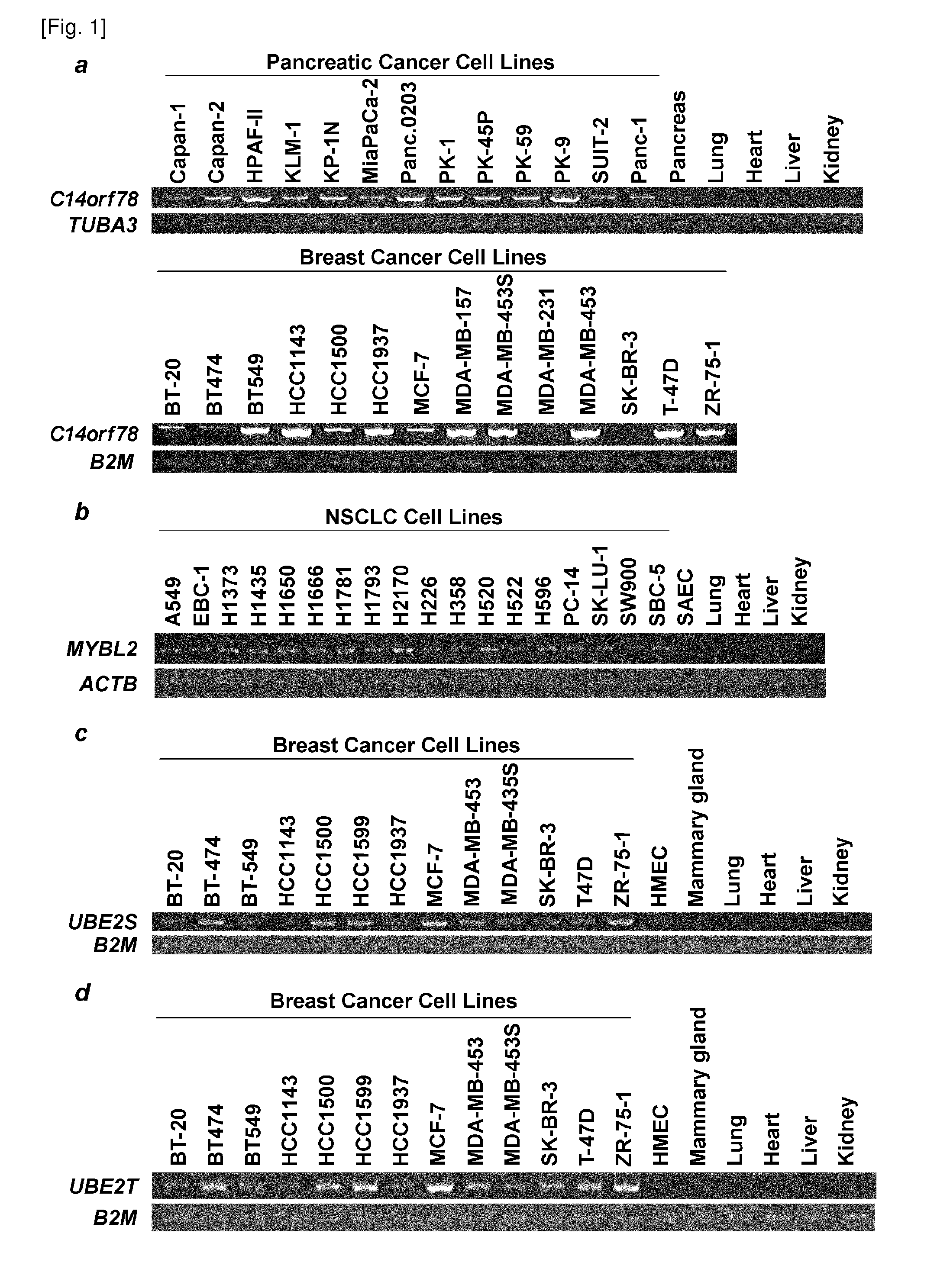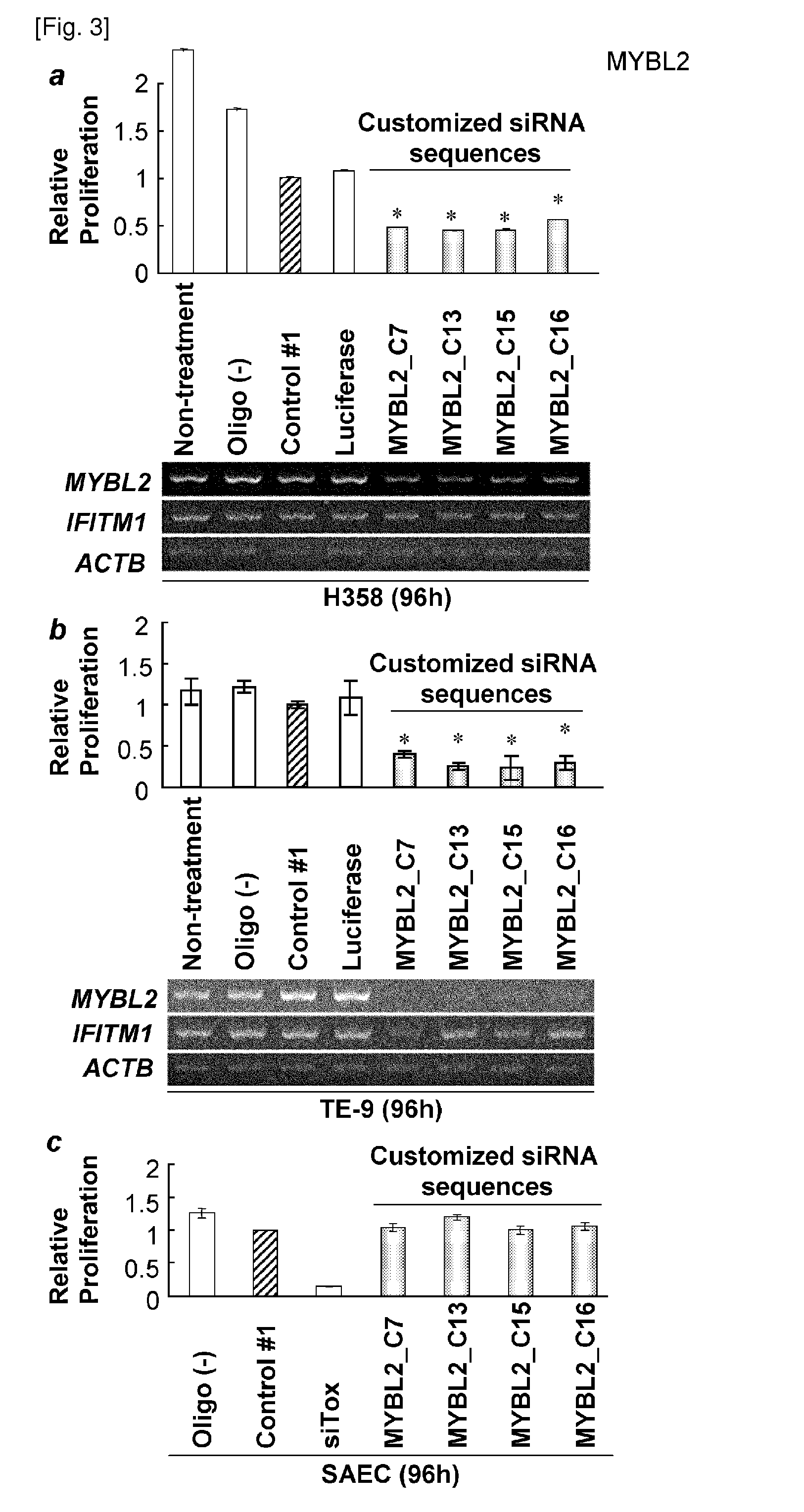Compositions and methods of treating cancer
a cancer and composition technology, applied in the field of biochemical science, can solve the problems of many patients becoming resistant to any therapy, no effective treatment option, limited long-term survival effect of treatments,
- Summary
- Abstract
- Description
- Claims
- Application Information
AI Technical Summary
Benefits of technology
Problems solved by technology
Method used
Image
Examples
example 2
Screening of Up-Regulated Genes in Clinical Cancer Samples with No or Low Expression in Normal Organs
[0316]cDNA microarray analyses was carried out as described previously (Zembutsu H et al., Cancer Res 2002 Jan. 15, 62(2): 518-27; Nishidate T et al., Int J Oncol 2004 October, 25(4): 797-819). By comparing expression patterns between cancer tissues and corresponding normal epithelia, genes commonly up-regulated in the clinical cancer tissues were selected. Next, semi-quantitative RT-PCR analysis was performed to select cancer-specific genes which were detected to be highly expressed in cancer cell lines but not in corresponding normal organs and normal vital organ (FIG. 1). Genes highly expressed in normal organs were eliminated to avoid suppositious induction of fatal side effects when used as target genes to be inhibited in therapy.
example 3
Design of Customized siRNA for Candidates
[0317]SiRNA sequences for each candidate genes were designed using siRNA design tool available on Ambion, Inc. website (http: / / www.ambion.com / techlib / misc / siRNA_finder.html) (Tuschl T et al., Genes Dev 1999 Dec. 15, 13(24): 3191-7) to select the candidate sequences of the siRNAs. Each of the siRNAs were introduced into cancer cells and control cells, and evaluated for their relative cell viability to obtain sequences that is most effective in suppressing cell growth (Table 1).
TABLE 1Designed siRNA sequences against the four candidate genesSEQTargetsiRNA IDGeneNameStrandSequenceNOC14C8target5′-GATATGCCATCCCAGATTT-3′47orf78Sense5′-GAUAUGCCAUCCCAGAUUUUU-3′25Anti-5′-AAAUCUGGGAUGGCAUAUCUU-3′26senseC10target5′-GTCAAATTCCCCAAATTAA-3′48Sense5′-GUCAAAUUCCCCAAAUUAAUU-3′27Anti-5′-UUAAUUUGGGGAAUUUGACUU-3′28senseC11target5′-GTGTCCAGAGGCCAATATT-3′49Sense5′-GUGUCCAGAGGCCAAUAUUUU-3′29Anti-5′-AAUAUUGGCCUCUGGACACUU-3′30senseC24target5′-GGCAGGGCTCCAAAAGACA-3′50...
example 4
Optimization of Gene-Specific siRNAs and Evaluation of their Silencing Specificity
[0318]C14orf78 is a therapeutic target for pancreatic cancer because it is over-expressed (T / N ratio>=5) in clinical samples; 11 of 18 pancreatic cancers, 14 of 25 cholangiocellular carcinomas, and 10 of 37 non-small cell lung cancers (Table 2). All of the optimized siRNAs for C14orf78 (C8, C10, C11 and C24) effectively knocked down gene expression in PK-1 and Panc.02.03 coincided with suppression of cell proliferation (FIGS. 2a, b). The present inventors further examined the activation of interferon pathway by double-stranded RNA (dsRNA) against the gene. Interferon induced transmembrane protein 1 (IFITM1) is an index of interferon response resulting in undesired non-specific cell death by the infection of double-stranded RNAs. In this invention, the expression of IFITM1 was almost concordantly unchanged (FIGS. 2a, b). Furthermore, the proliferation of SK-BR-3, which is a cell line expressing low leve...
PUM
| Property | Measurement | Unit |
|---|---|---|
| Length | aaaaa | aaaaa |
| Cell growth | aaaaa | aaaaa |
Abstract
Description
Claims
Application Information
 Login to View More
Login to View More - R&D
- Intellectual Property
- Life Sciences
- Materials
- Tech Scout
- Unparalleled Data Quality
- Higher Quality Content
- 60% Fewer Hallucinations
Browse by: Latest US Patents, China's latest patents, Technical Efficacy Thesaurus, Application Domain, Technology Topic, Popular Technical Reports.
© 2025 PatSnap. All rights reserved.Legal|Privacy policy|Modern Slavery Act Transparency Statement|Sitemap|About US| Contact US: help@patsnap.com



